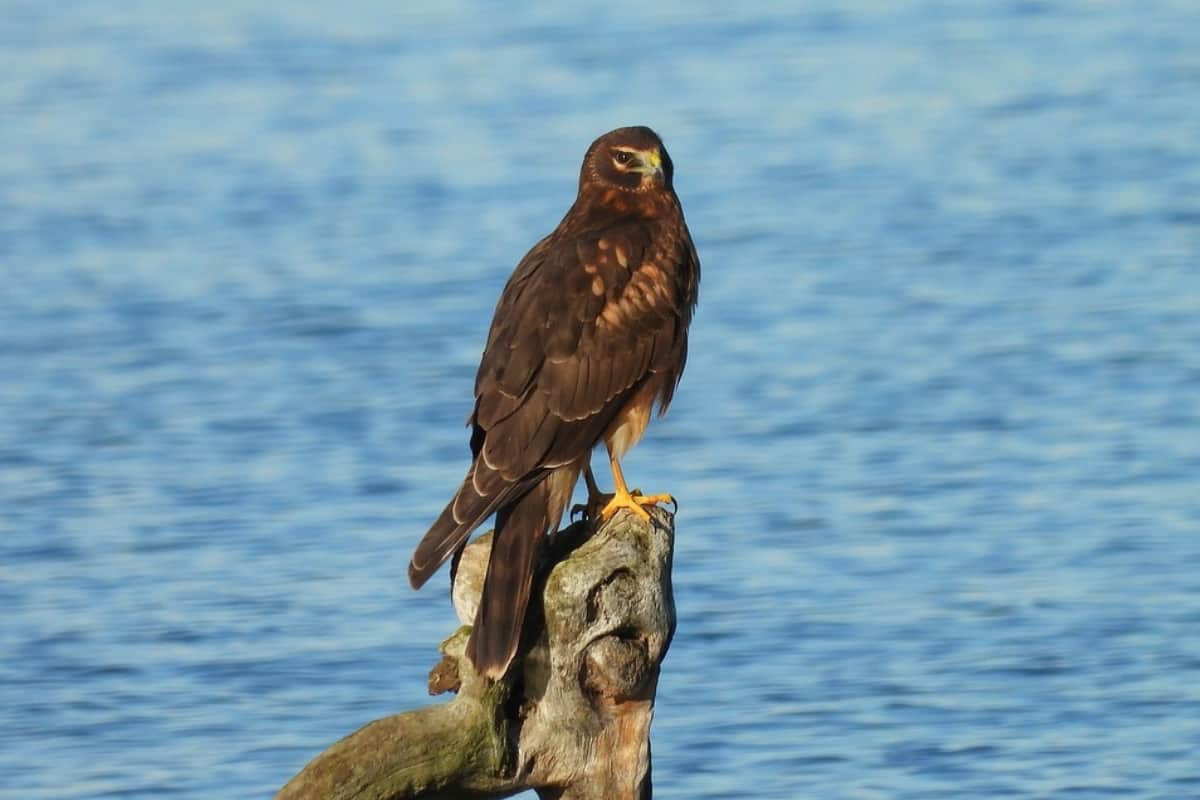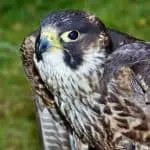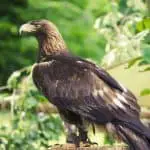Common Name: Northern Harrier
Scientific Name: Circus Hudsonius| Size | Diet | Range in Hawaii | Status in Hawaii |
|---|---|---|---|
| 18 in. - 20 in. | mice, voles, shrews, and rabbits | Kaua'i, O'ahu, Moloka'i, Maui, and Big Island | Least Concern |
The Northern Harrier (Circus Hudsonius) is a bird of prey that is known for its distinctive hunting style and striking appearance. With its long wings and owl-like face, this harrier is a fascinating bird to watch in action. While it is native to North America, it has also been spotted in Hawaii, making for a rare and exciting sighting for birdwatchers on the islands. In this article, we’ll explore the fascinating world of the Northern Harrier and learn more about its unexpected presence in Hawaii.
Northern Harrier
Appearance
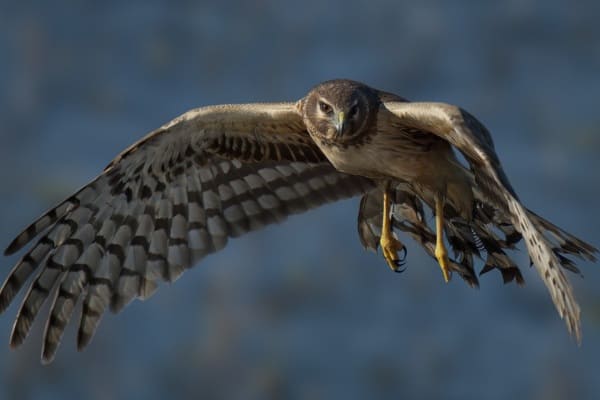
The Northern Harrier, scientifically known as Circus hudsonius, is a medium-sized raptor with distinct features. The adult male has a length ranging from 18 to 20 inches (46 to 51 centimeters), while the adult female is slightly larger, measuring between 19 to 22 inches (48 to 56 centimeters). It has a long, slim body and broad wings with a wingspan of around 40 to 46 inches (102 to 117 centimeters).
The Northern Harrier has a unique plumage pattern. Adult males have a grayish-brown back, light gray undersides, and a white rump. They also display a distinctive gray head with a white patch around the base of the bill. In contrast, adult females and immature birds have a dark brown upper body with streaks and a buffy or creamy underside that is heavily streaked. Their facial pattern includes a dark eye patch.
One remarkable characteristic of the Northern Harrier is its facial disk, which resembles that of an owl. This disk aids in directing sound and helps them locate prey. Additionally, they have long, slender tails that are horizontally positioned during flight, distinguishing them from other raptors.
Diet
The Northern Harrier is a medium-sized bird of prey that is primarily found in North America. As a raptor, its diet consists mainly of small mammals, making it an effective hunter of rodents. However, the Northern Harrier is unique among hawks and eagles as it is also known to include a significant amount of birds, reptiles, and insects in its diet.
The primary food source for Northern Harriers is small mammals such as mice, voles, shrews, and rabbits. They employ a low, slow-flying hunting technique, known as “quartering,” where they fly just above the ground, searching for movement in the grassy or marshy habitats they inhabit. Once prey is detected, the harrier will swiftly dive down and snatch it up using its sharp talons.
In addition to mammals, Northern Harriers will also prey on birds such as meadowlarks, sparrows, and small waterfowl. They have a particular affinity for birds nesting on the ground or in low vegetation. During the breeding season, they may even capture birds and feed them to their young.
Furthermore, the Northern Harrier’s diet may include reptiles such as snakes and lizards, as well as amphibians like frogs and toads. Insects such as grasshoppers, dragonflies, and beetles also make up a small portion of their diet, especially during the summer months when these prey items are abundant.
The versatility of the Northern Harrier’s diet allows it to adapt to a variety of habitats, including marshes, grasslands, meadows, and agricultural fields. Its ability to catch prey in flight, on the ground, or even in shallow water gives it an advantage in finding sustenance.
Nesting
The Northern Harrier exhibits a distinctive nesting behavior compared to other raptors. Instead of building elaborate nests in trees or cliffs, the Northern Harrier constructs its nest directly on the ground. Typically found in open grassy or marshy habitats such as wetlands, meadows, or prairies, the female harrier chooses a concealed location amidst tall vegetation to create a shallow depression as the nest.
She lines it with twigs, grass, and plant materials to form a rudimentary structure. The nest is relatively simple, measuring around 15-20 inches in diameter. After constructing the nest, the female lays a clutch of 4 to 6 pale blue or greenish-white eggs with dark speckles.
She alone incubates the eggs for about 30 to 32 days, while the male provides food. Once the eggs hatch, both parents care for the chicks, with the female primarily brooding and the male hunting for food.
The chicks fledge at around 30 to 35 days old, gradually gaining independence as they learn to hunt. The Northern Harrier’s ground-level nesting behavior allows them to blend in with their surroundings and successfully raise their young in open grassy habitats.
Behavior
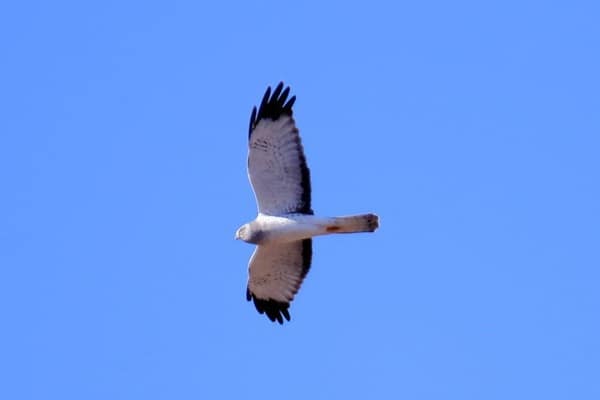
The behavior of the Northern Harrier is fascinating and distinct among raptors. Known for their low-flying hunting technique, these birds soar over open habitats, such as grasslands and marshes, gliding and hovering as they search for prey. Their agile flight allows them to swiftly change directions and maneuver with ease.
Northern Harriers communicate using various vocalizations, emitting a high-pitched, shrill call that resonates through their habitat. During courtship, males perform remarkable aerial displays known as “sky-dancing,” showcasing their aerial prowess and emitting distinctive calls to attract females.
When it comes to nesting, Northern Harriers are ground-nesters, constructing their nests on the ground, usually hidden amidst tall vegetation. The female incubates the eggs while the male provides her with food. Both parents actively care for the hatchlings until they fledge.
While Northern Harriers are generally solitary, they may form small groups during migration or when food resources are abundant, displaying tolerance towards conspecifics. This species undertakes migratory journeys, with some individuals traveling long distances to reach their wintering grounds. The behavior of the Northern Harrier exemplifies their adaptability, agility, and unique strategies for survival.
Habitat
Northern Harriers have a slim and long-winged shape, allowing them to soar and glide effortlessly across open fields, marshes, and grasslands where they primarily hunt. They have a characteristic flight pattern, often described as low and buoyant, with their wings held in a V-shape. This flight style, combined with their owl-like facial disk, gives them the nickname “marsh hawk.”
These raptors are highly adaptable and have the ability to hover and maneuver in mid-air while searching for prey. They primarily feed on small mammals, such as voles, mice, and rabbits, which they locate by using their exceptional hearing and keen eyesight. Their facial disk helps funnel sound to their ears, allowing them to detect the faintest rustling of their prey in the grass.
During the breeding season, Northern Harriers engage in elaborate courtship displays, which involve the male performing acrobatic flight maneuvers to attract a female. They typically nest on the ground in dense vegetation, creating a shallow depression lined with grass and other materials.
Northern Harriers are also known for their territorial behavior. Males defend their nesting areas and hunting grounds vigorously, often engaging in aerial displays and vocalizations to communicate their presence and boundaries to other harriers.
Range
The Northern Harrier, a species of harrier, can be found in the Hawaiian Islands. It is primarily observed in the Northwestern Hawaiian Islands, including Kure and Midway. In the Southeastern Hawaiian Islands, sightings have been recorded on Kaua’i, O’ahu, Moloka’i, Maui, and Hawai’i Island. The presence of the Northern Harrier in Hawaii indicates its ability to migrate and disperse across the Pacific region.
Conservation Status

The conservation status of the Northern Harrier is currently classified as “Least Concern” by the International Union for Conservation of Nature (IUCN). This designation indicates that the species is not facing an immediate threat of extinction on a global scale.
Interesting Facts
1. Unique hunting behavior
The Northern Harrier is one of the few raptor species that relies heavily on hearing to locate prey. They have an owl-like facial disk that helps channel sound to their ears, enabling them to detect small mammals hiding in grasses.
2. V-Shaped flight
The Northern Harrier stands out among other raptors with its distinctive flight style. It frequently glides at low altitudes, hugging the ground, while holding its wings in a V-formation. This flight pattern, along with its slender physique, enables the harrier to navigate effortlessly through open environments.
3. Nomadic migrations
Northern Harriers are known for their nomadic tendencies. In response to changes in prey availability and habitat conditions, they can exhibit migratory behavior, moving long distances in search of suitable foraging areas.
4. Polygynous breeding system
Northern Harriers typically practice polygyny, where one male mates with multiple females. Males perform aerial courtship displays, including sky-dancing, to attract mates. Females choose a nesting site and raise the young on their own.
5. Sexual dimorphism
Male and female Northern Harriers exhibit striking differences in appearance, a phenomenon known as sexual dimorphism. Males have gray plumage with black wingtips, while females are brown with streaks and have a white rump patch. This distinction helps researchers identify the sexes.
Frequently Asked Questions
1. Are Northern Harriers social birds?
Northern Harriers are generally solitary birds, but they may gather in small groups during migration or in areas with abundant food resources. They do not exhibit strong social behavior like some other bird species.
2. How can I identify a Northern Harrier in flight?
Northern Harriers have a distinct flight style. Look for their low flight over open areas with their wings held in a V-shape. They also have a characteristic white rump patch, and males exhibit gray plumage with black wingtips, while females are brown with streaks.
3. How do Northern Harriers communicate with each other?
Northern Harriers communicate through a variety of vocalizations. Males and females emit different calls, including high-pitched whistles and raspy notes. They use these vocalizations to communicate during courtship, territorial disputes, and interactions with their young.
4. How long do Northern Harriers live?
The lifespan of Northern Harriers can vary, but on average, they live up to around 10 years in the wild. However, there have been recorded cases of individuals living beyond 20 years, highlighting their potential for longevity.
